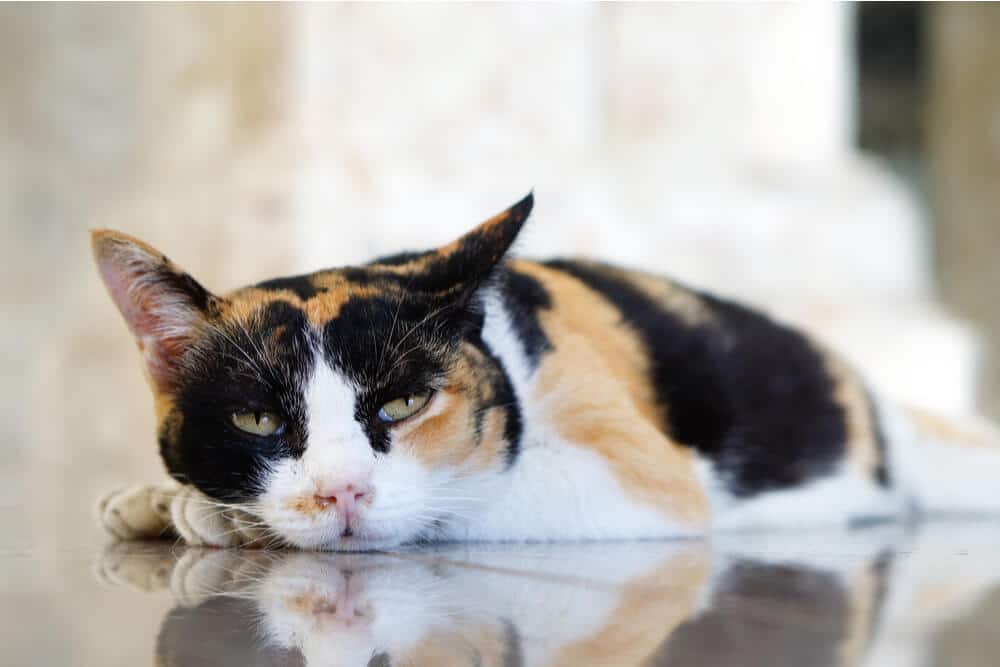
Azathioprine is a medication used for immunosuppression to treat autoimmune diseases. Common brand names include Imuran and Azasan. It is rarely used in cats, but may be indicated under certain circumstances. In this article, you’ll learn what azathioprine is, why it is a higher-risk medication for cats, what side effects to monitor for, and some frequently asked questions.
Azathioprine For Cats Overview

About Azathioprine for Cats
Azathioprine is a medication that suppresses the function of the immune system. This type of medication can be necessary if the immune system is attacking a part of the body and leading to disease and illness. Examples of immune-mediated diseases include inflammatory bowel disease, immune-mediated anemia, and many others.
Azathioprine is very rarely used in veterinary medicine for immune-mediated diseases in cats because the side effects tend to be more severe in cats compared to humans and dogs. There are more commonly used immunosuppressive medications for cats that would be considered before azathioprine. An example would be cyclosporine and higher doses of a steroid like prednisolone.
Also Read: 6 Surprising Similarities Between Cats And Dogs
What Does Azathioprine Do for Cats?
Azathioprine is rarely used in cats due to the much higher likelihood of side effects. The main concerning side effect is called myelosuppression. This is when a drug can suppress the bone marrow’s production of red blood cells, white blood cells, and platelets.
The effects of myelosuppression can lead to anemia from a lack of red blood cells, opportunistic infections from a lack of white blood cells, and spontaneous bleeding or bruising from a lack of platelets. These effects can be life-threatening if not addressed. In dogs and humans, these effects are less common or may take several months before they manifest. But in cats, these effects occur more quickly and severely.
The reason for this is related to an enzyme called thiopurine methyltransferase (TPMT) which is used by the body to metabolize azathioprine. Dogs and humans have variable activity of TPMT, leading some to experience myelosuppressive side effects while others do not. In cats, TPMT is universally very low, causing bone marrow suppression in nearly all cases.
While there are high risks when using this medication in cats, there may be some rare cases where it may still be prescribed if other immunosuppressive medications were not successful. In these cases, certain protocols are used. Very close monitoring is needed to catch any signs of bone marrow suppression as soon as possible.
In cases where azathioprine is used, it may take several weeks before effects on the immune-mediated disease condition are seen.
Side Effects of Azathioprine for Cats

Lethargy is one of the side effects that can come with the use of azathioprine.
Side effects of azathioprine are divided into a couple of categories. The first is the effects of bone marrow suppression. These signs of adverse effects may include fever, lethargy, bruising (anywhere on the body including in the mouth), bleeding, pale gums, vomiting, and poor appetite.
Gastrointestinal side effects can be common with this drug. These signs may include vomiting, lack of appetite, diarrhea, and excessive drooling (hypersalivation). Pancreatitis is reported as a side effect in dogs, which in cats may only present as an acute loss of appetite, lethargy, and sometimes signs of abdominal discomfort.
Azathioprine may also cause toxicity, leading to liver disease. Signs of this effect may include yellowing of the whites of the eyes, skin, and gums (icterus or jaundice), as well as previously mentioned effects.
If you are ever concerned that your kitty may have developed side effects while using azathioprine or if an overdose is suspected, make sure to contact your veterinarian who prescribed the medication, the ASPCA Animal Poison Control Center (1-888-426-4435), or Pet Poison Helpline (1-855-764-7661) immediately for further advice.
It is also very important to note that gloves should be worn when handling azathioprine. It should not be handled at all by pregnant individuals.
There are several medications that azathioprine may interact with. Make sure that your vet is fully aware of any other medications or supplements your cat is taking if azathioprine is being considered for treatment.
Also Read: What To Do If Your Cat Is Hit By A Car: A Step-By-Step Guide
Dosage of Azathioprine for Cats
Azathioprine tablets are FDA approved for humans but are used off-label in cats or dogs. Azathioprine is used far more often in dogs. Since it is used rarely in cats and has not been studied well in cats due to pronounced its side effects, no dosing information is available.
If your veterinarian has prescribed azathioprine, there is likely a very good reason for this choice. If you have any questions about why the medication was prescribed or if you’re seeing any side effects in your kitty, it’s very important to contact your vet before stopping this medication.
Because of the bone marrow suppression effects, bloodwork monitoring is crucial when a pet is on azathioprine. Because of the higher risk in cats, bloodwork may be performed more frequently than in dogs. This can be as often as every 1-2 weeks, down to once a month.
Final Thoughts

With careful care and monitoring, a cat may benefit from azathioprine when safer medications aren’t cutting it.
Azathioprine is an immunosuppressive medication rarely used in cats because of the high chance of bone marrow suppression effects. It is also a less popular choice because there are other immunosuppressive medications with a lower risk of adverse effects.
This medication may still be used in rare cases for certain disease conditions in which case very careful monitoring and frequent communication with the prescribing vet is needed.
Drug Dosing Disclaimer: We are only able to provide doses for medications that are FDA approved for use in cats and only as the label guidelines dictate. For medications that are used off-label we can only provide guidelines and safety information for use. Safe and appropriate dosing for off-label medications can only be determined by a primary care veterinarian.
We encourage you to work with your veterinarian to determine if a particular medication is appropriate for your cat. Changing or adjusting a dose for your cat on your own without consulting with a veterinarian can carry risk. We do not encourage use of medications prescribed for human use in pets without first consulting with a primary care veterinarian.
Frequently Asked Questions
What does azathioprine treat?
Azathioprine is an immunosuppressive medication. This means that it suppresses the immune system in cases where the immune system attacks a normal part of the body, causing an autoimmune disease. There are many types of diseases under this category including inflammatory bowel disease, immune-mediated hemolytic anemia (red blood cell loss), and immune-mediated thrombocytopenia (loss of platelets).
Is azathioprine a high-risk medication?
In cats, azathioprine is considered a high-risk medication. Other immunosuppressive medications are typically considered first before azathioprine due to concern for side effects including bone marrow suppression, gastrointestinal effects, pancreatitis, and liver toxicity.
Because cats have a very low concentration of an enzyme used to metabolize azathioprine, bone marrow suppression is a very high risk, making azathioprine a very rare medication choice for use in cats.
What are the most common side effects of azathioprine?
The most common adverse effects of azathioprine include gastrointestinal effects like vomiting, diarrhea, poor appetite, and effects from suppression of the bone marrow’s production of red blood cells, white blood cells, and platelets.
Bone marrow suppression signs may include bruising, spontaneous bleeding, weakness, poor appetite, and lethargy.
Azathioprine may also cause liver toxicity, which can outwardly appear as a yellowing discoloration of the skin, whites of the eyes, and gums. Other signs like vomiting, poor appetite, and lethargy may also be seen.
Pancreatitis is a common concern in dogs on azathioprine but the prevalence in cats is not well known as the drug is not used often in cats. Pancreatitis in cats may present only as an acute loss of appetite with or without signs of abdominal discomfort.
How long does it take azathioprine to work?
It may take several weeks (at least 5-6) for outward signs of improvement to be seen when azathioprine is used to treat an immune-mediated condition. Signs of improvement to monitor for will depend greatly on the condition being treated.







